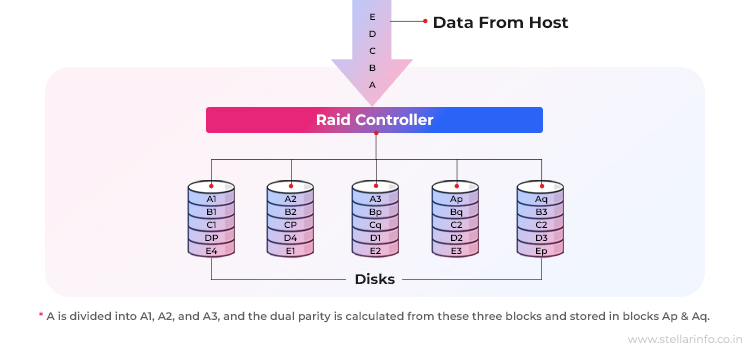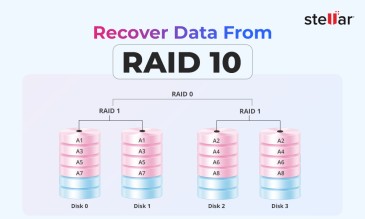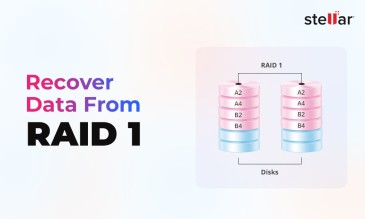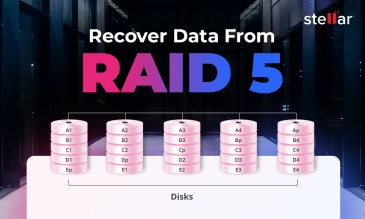Summary:
- RAID 6 is a secure storage configuration that protects your data with dual parity and lets you recover information even if any two drives fail.
- However, data loss can still happen in RAID 6 storage, particularly when you spot warning signs like array degraded status, repeated errors, or slow access.
- Typical RAID 6 failures show up as single or dual disk failure, controller issues, or logical errors.
- RAID 6 recovery is possible but only if you have the required number of working drives and the original configuration.
- If your RAID 6 fails, do not attempt DIY data recovery. Always rely on a trusted RAID data recovery service.
Introduction to RAID 6 Data Recovery
RAID (which stands for “Redundant Array of Independent Disks”) is a way of combining several hard drives into one logical unit for better speed, capacity, or data safety. Among all raid types, RAID 6 is unique for its strong protection against data loss.
RAID 6 works by splitting your data across several drives and adding not one, but two layers of parity information. That means even if two drives fail at the same time, your files are still safe.
For this reason, RAID 6 is a popular choice for servers, large storage arrays, and anyone who simply can’t afford to lose their data.In fact, many consider RAID 6 the gold standard for reliability in critical environments.
But does this mean your data is totally safe forever in a RAID 6? Not quite.
Even with these extra protections, things can still go wrong, and when they do, RAID 6 data recovery becomes your only option.
Before we explain how hardware engineers approach RAID 6 data recovery, let’s dig deeper into what makes RAID 6 special, both in terms of how it protects data and how it makes data recovery challenging when data is lost or corrupted.
RAID 6 Meaning and How It Works
RAID 6 is one of several RAID types. What sets it apart from other RAID levels is its use of dual parity. This means that for every “stripe” of data written across the disks, two separate blocks of parity information are also written, and each parity bit is calculated differently. This setup allows RAID 6 to handle up to two disk failures at once without losing any data.

To understand how this dual-parity setup allows RAID 6 to become resistant to data loss risks, please refer to our guide on how RAID 6 works.
Key Points About RAID 6
- At least four disks are required in a RAID 6 configuration: two for data and two for parity.
- In RAID 6, data and parity are both distributed across all the drives and there’s no dedicated “parity disk.”
- If one or even two disks fail, your data is still fully recoverable thanks to the dual parity.
This architecture makes RAID 6 a preferred option in environments where downtime or data loss is unacceptable.
Why Data Loss Can Still Happens on RAID 6
Our description of RAID 6 above may have tempted you to believe that this storage configuration is completely immune to data loss.
That’s wrong.
While RAID 6 offers outstanding protection compared to other RAID types, the reality is that data loss can still occur in RAID 6.
Here are some reasons why data loss may still happen on RAID 6 systems:
- More than two disks fail at the same time.
- Unnoticed (silent) corruption or bad sectors build up on multiple disks.
- Controller or firmware problems cause the array to lose track of how disks are organized.
- Power surges or environmental issues (like heat or vibration) damage the hardware.
- Human errors such as accidental deletion, formatting, or misconfiguration can also make files disappear.
Even if your hardware is top-notch, RAID 6 is not a substitute for a backup.
If anything goes wrong beyond the built-in redundancy, the only way to recover RAID 6 data is through expert RAID 6 data recovery processes.
Common Failure Modes in RAID 6
To really understand RAID 6 data recovery, you need to understand the different categories of RAID 6 data loss situations. So let’s break down the typical ways RAID 6 arrays can fail.
Single disk failure
The array keeps running and you have time to swap out the failed disk. No data loss, as long as you act quickly.
Dual disk failure
Even with two drives down, RAID 6 can rebuild the lost data. But this is your last line of defense.
Multiple disk failures
If three or more drives fail, the array can’t recover by itself. This is where you need professional RAID 6 recovery.
Controller or software issues
Sometimes all disks can be healthy, but the RAID controller fails or its configuration is lost or corrupted. In such cases, you can lose access to the array even though the drives are fine.
Logical or human errors
Mistaken deletions, reformats, or software corruption make data inaccessible, even if there has been no physical failure.
In all these cases, you need to know the root cause is crucial to plan your next steps.
When is RAID 6 Recovery Possible
So, when can you actually recover RAID 6 data successfully?
The answer depends on a few technical rules and constraints that are unique to this setup. You need to understand these boundaries before trying any raid data recovery.
Here’s the bottom line: RAID 6 controller can handle up to two failed disks
This is the golden rule for RAID 6 recovery. As long as you have all but two disks intact and readable, you can recover the full dataset using the dual parity information.
Accurate configuration info is critical
You need to know the original array’s settings such as drive order, stripe size, and parity scheme. If this info is lost, recovery becomes much harder.
Three or more total drive failures is usually unrecoverable
If more than two drives are completely lost or unreadable, most data is gone. In rare cases, partial recovery is possible if not all missing data overlaps in the same stripe.
Partial failures can be complex
If several disks have bad sectors (but not fully dead), you can reconstruct everything, but only if no more than two disks are unreadable in any given stripe.
If you keep these technical constraints in mind, you’ll improve your odds of successful RAID 6 recovery.
RAID 6 Data Recovery: Should You Do It Yourself?
Unlike simpler RAID types, the double parity system of RAID 6 introduces technical hurdles that only experienced RAID data recovery experts can truly navigate.
Here are some of the risks and complexities you face with RAID 6 recovery:
- Vendor-Specific Parity Schemes: Each manufacturer implements the second parity block (Q parity) differently, with proprietary code. This means standard recovery tools will fail or give unreliable results.
- Configuration Confusion: If you don’t have precise details about the original array (like drive order or stripe size), you will find it very difficult to reassemble the array virtually.
- Partial Failures: Sometimes, disks haven’t completely failed but have scattered bad sectors. If more than two unreadable blocks occur in the same stripe, that data is lost.
- Risk of Stale or Inconsistent Data: If one disk failed and was left degraded for a long time before a second disk failed, data would not be fully synchronized, which makes recovery more complex.
- Danger of DIY Errors: Common mistakes such as swapping drives, reinitializing the array, or running “fix” tools without a full backup causes permanent data loss.
So, incorrect attempts to rebuild or reconfigure the array make things worse. Instead, you should go straight to professional help for complex RAID 6 data recovery cases.
In our 30+ years of experience in dealing with RAID data loss scenarios, we’ve perfected a RAID 6 data recovery approach that helps us recover data in up to 85% of cases.
The Stellar Approach to RAID 6 Recovery: Step-by-Step
Wondering how we approach RAID 6 data recovery? Here’s a typical approach:
- Initial assessment: We start with a detailed evaluation of your RAID 6 array and understand possible failure scenarios.
- Drive imaging: We clone every member disk to secure storage, so your data is never at risk.
- Virtual reassembly: We virtually reconstruct the RAID by using your configuration details (or by analyzing metadata). During this process we mark your failed or missing drives, and use both parity blocks to recover lost data.
- Parity verification and error correction: We check for inconsistencies, repair file systems, and ensure maximum data integrity.
- Secure data extraction: We copy your files onto safe, healthy media for return.
- Support and advice: We guide you on preventive steps to reduce future risks, and help you implement backup or monitoring solutions if needed.
Our goal is simple: recover your data, safely and completely, with minimal downtime and maximum transparency.
Why You Should Trust Stellar Data Recovery for RAID 6
If you search “RAID 6 data recovery services near me”, you’ll find many options, but not all are true RAID data recovery experts.
What sets Stellar Data Recovery apart is our deep experience with all RAID types and a proven process specifically for RAID 6 arrays.
Here’s what we offer as a RAID 6 data recovery specialist.
- Expertise in dual parity and proprietary RAID 6 setups
- Safe imaging and ISO certified Class 100 cleanroom recovery
- Custom software and tools tailored for RAID 6 data recovery challenges
- Transparent, step-by-step communication
- A data recovery lab near you, with the option of guided, safe, and free pickup of your hardware from your home.
Our track record with RAID 6 data recovery means your data is in the safest possible hands.
Gain deeper knowledge on RAID types, failures, and how recovery works. Take a look at the following articles:
FAQs
Unexpected slowdowns, repeated disk errors, or a degraded array warning are signs of trouble. If two disks fail, urgent RAID data recovery is needed to protect your data.
You need the correct drive order and configuration for successful RAID 6 recovery. Professional RAID 6 data recovery experts can reconstruct this, but you are likely to fail trying to do it yourself.
Yes, it is possible as long as no more than two drives have failed per stripe.
Costs for RAID data recovery services depend on array size, damage, and urgency.
No. RAID 6 only guards against hardware failure. For accidental deletions or logical errors, you’ll need file-level recovery from the best data recovery service.
About The Author

Data Recovery Expert & Content Strategist












